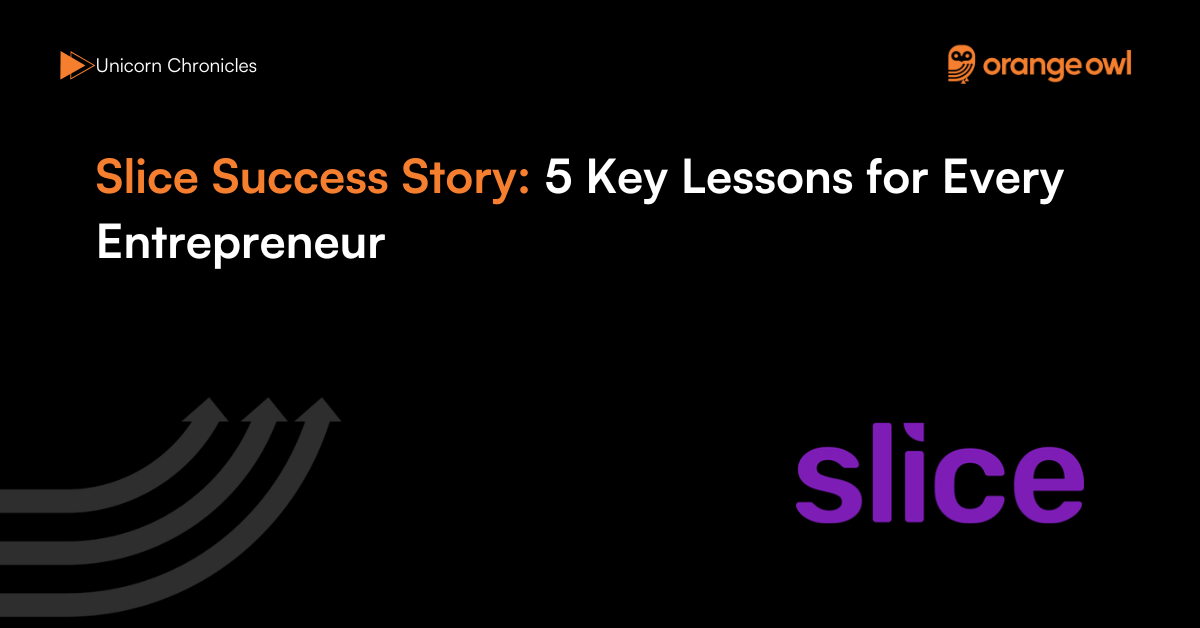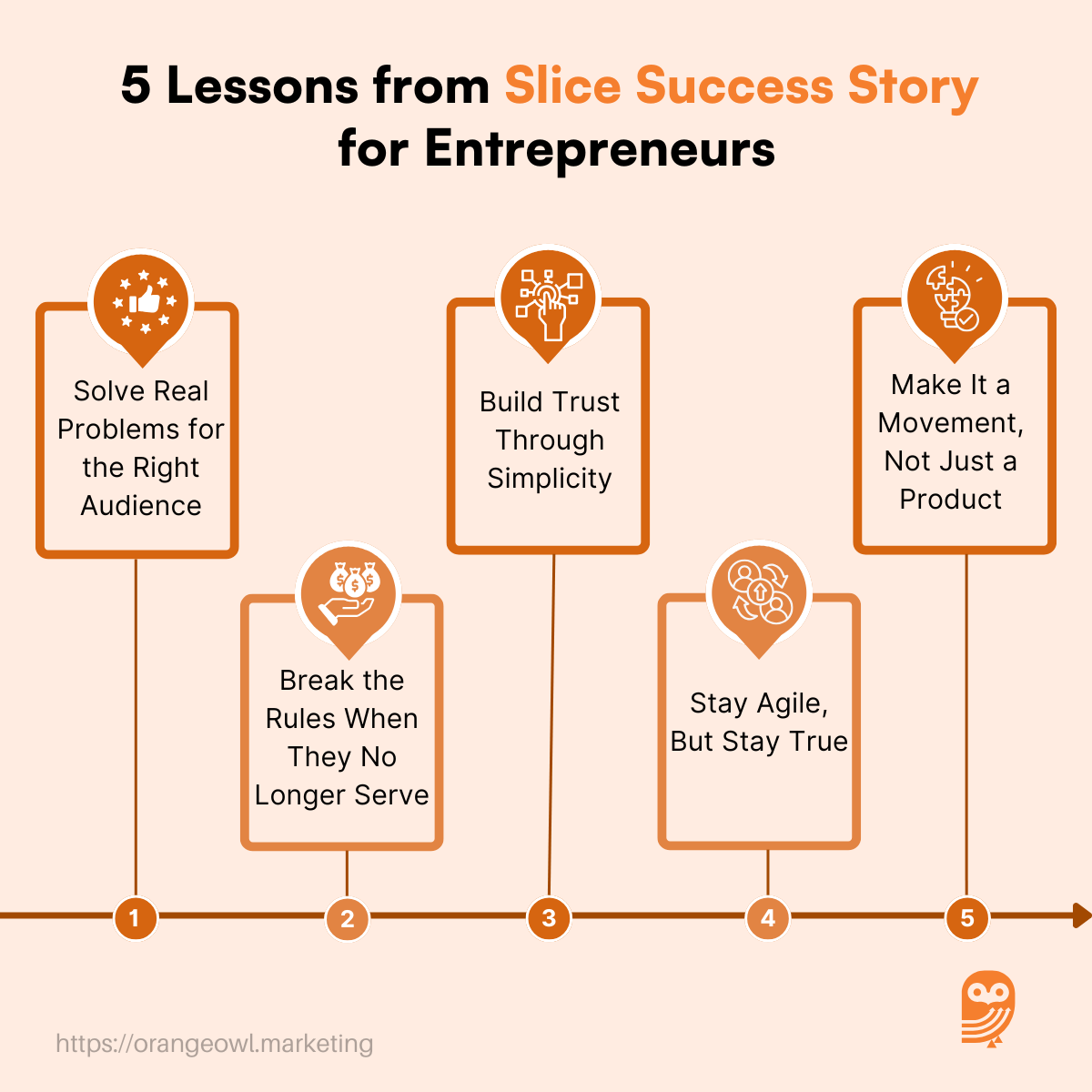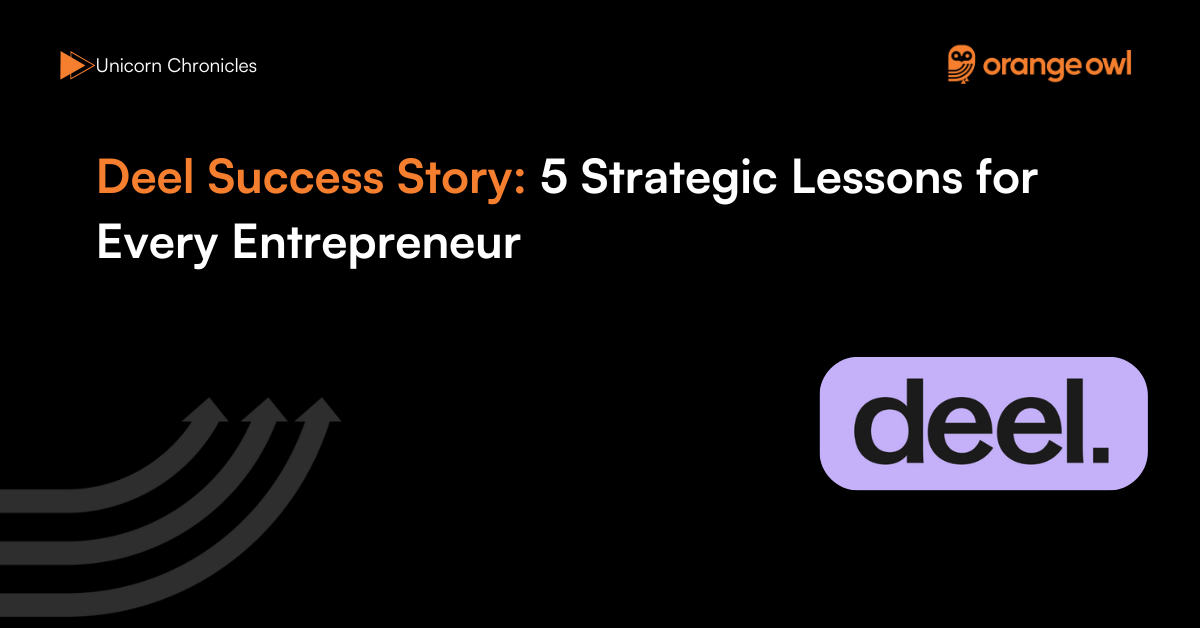Slice Success Story: 5 Key Lessons for Every Entrepreneur
Vivek Goel
May 5, 2025

Table of Contents
Introduction
In India’s rapidly evolving fintech landscape, Slice has emerged as a transformative force, redefining how young Indians access and manage credit. Founded in 2016 by Rajan Bajaj, Slice set out to address a significant gap: the lack of accessible credit options for students and early-career professionals often overlooked by traditional banks.
“We’re building something that puts the customer first, simplifies finance, and brings dignity to credit.” — Rajan Bajaj, Founder of Slice
Since its inception, Slice has experienced remarkable growth. As of 2025, the company boasts a user base exceeding 17 million across India, providing financial services to individuals who were previously unbanked or underbanked.
Financially, Slice has demonstrated robust performance. The company is currently operating at an annual revenue run-rate of approximately ₹1,200 crore (around $145 million).
In terms of capital, Slice has successfully raised $380.87 million across 15 funding rounds, with the most recent round occurring in June 2024.
A major turning point in Slice’s journey came in October 2024, when it announced its merger with North East Small Finance Bank, a move approved by the Reserve Bank of India (RBI). This strategic merger allowed Slice to evolve into a regulated banking entity, opening the doors for expanded product offerings and long-term scalability.
With this transition, Slice Bank has set a bold goal: growing its customer base from 11 million to 70 million by 2030, establishing itself as one of the most ambitious neobanks in the country.
“We are building a bank that aligns with the lifestyle of today’s India.” — Rajan Bajaj, Founder of Slice
Slice’s journey is not just about numbers—it’s about a steadfast mission to empower a generation with the financial tools they need to thrive. Through innovation, empathy, and customer-first design, Slice continues to reshape the financial landscape for India’s youth.
Origin Story
Slice was founded in 2015 by Rajan Bajaj, an IIT Kharagpur graduate and former Flipkart employee. During his time in India’s emerging tech and e-commerce space, Bajaj became increasingly aware of a glaring inefficiency in the financial system—young, tech-savvy Indians lacked access to basic credit services.
Despite being active consumers and digitally engaged, students and young professionals were routinely denied credit by traditional banks due to their lack of credit history or formal income documentation.
“I was frustrated seeing how banks treated young people when it came to credit.”
— Rajan Bajaj, Founder of Slice
This frustration became the spark behind Slice. Bajaj envisioned a product that could serve as a financial starting point for young Indians—a solution that would offer simplicity, transparency, and dignity in credit access. What began as an experiment to reimagine credit for the youth soon evolved into a full-fledged fintech platform. Bajaj’s early venture, Mesh, helped him understand customer pain points more intimately, paving the way for Slice’s development.
Slice stood out by rejecting the traditional credit model that emphasized bureaucracy and paperwork. Instead, it focused on creating a digital-first experience. The flagship offering, the Slice Super Card, was specifically designed for those new to credit. With flexible limits, instant digital onboarding, and a sleek mobile interface, the Super Card became more than a financial tool—it became a symbol of trust and empowerment for its users.
“We wanted to build a product that this generation would be proud to use, that understood them better.”— Rajan Bajaj, Founder of Slice
The company’s early decisions—like keeping the product simple, removing hidden charges, and offering intuitive repayment options—helped build trust with first-time credit users. Slice wasn’t just offering a credit card alternative; it was offering a new philosophy around how young people should be treated in the financial system.
Business Landscape and Early Challenges
Building a fintech startup in India—especially one offering credit—is a challenge layered with complexity. The financial services industry is not only highly regulated but also deeply entrenched in legacy systems that favor large, established institutions. For a newcomer like Slice, entering this domain required more than just innovative ideas—it demanded exceptional resilience, regulatory understanding, and trust-building from scratch.
From the outset, Slice had to win over two critical but very different stakeholders: customers and regulators. Young consumers were skeptical of credit products, often associating them with hidden fees, penalties, and poor experiences with traditional banks. On the other hand, regulators viewed credit to students and fresh professionals as high-risk, given the lack of formal income and credit history.
“In the early days, we faced massive skepticism. The idea of offering credit to students seemed absurd to many.” — Rajan Bajaj, Founder of Slice
Convincing investors wasn’t easy either. Many questioned the feasibility of lending to a largely unproven demographic. Yet Bajaj remained steadfast in his belief that India’s digitally native youth, though underserved, represented a powerful and scalable market. He envisioned a future where responsible, tech-enabled credit access could be the norm for India’s next generation of earners.
Slice also had to navigate the intricacies of compliance and data security. In a sector where trust is paramount, the startup built robust risk management protocols and invested heavily in data encryption and AI-driven fraud detection to assure users and regulators alike. These efforts became even more critical as Slice scaled its operations.
The COVID-19 pandemic in 2020 added an entirely new set of challenges. While many fintechs cut back lending, fearing widespread defaults and economic slowdown, Slice took a contrarian approach. The company chose to continue offering services, believing that financial support was needed more than ever—especially among its target users who were grappling with uncertainty.
“We believed our customers needed us more than ever. It wasn’t the time to shy away, but to lean in.” — Rajan Bajaj, Founder of Slice
This bold move paid off. Slice not only retained customer loyalty during a volatile period but also positioned itself as a trusted ally in times of crisis. The pandemic became a proving ground for the company’s resilience and customer-first philosophy, reinforcing its reputation as a fintech built for real-world needs.
Growth Strategies
Slice’s growth wasn’t just a result of timing or market demand—it was the outcome of deliberate choices rooted in user empathy, innovation, and bold strategic thinking. From the beginning, the company focused on delivering a user-first experience that made accessing credit as easy as ordering food online.
With its app-first interface, minimal documentation requirements, and instant approvals, Slice dramatically reduced the friction associated with getting a credit product. This intuitive onboarding helped the brand gain early traction, especially among students and young professionals new to the credit ecosystem.
Product innovation played a crucial role in Slice’s rise. The flagship Slice Super Card was designed not just as a credit tool, but as a lifestyle companion. Features like flexible repayment schedules, personalized cashback, and interest-free EMIs positioned it as a smart, aspirational alternative to traditional credit cards. For India’s digitally savvy youth, this was a fresh and relevant proposition that aligned with their financial habits.
As regulatory pressures intensified—particularly around BNPL models—many fintechs struggled to adapt. Slice, however, made a game-changing move by merging with North East Small Finance Bank. This gave it access to a banking license, allowing it to broaden its service offerings while operating under RBI regulations. This bold pivot turned Slice from a nimble fintech to a full-stack digital banking entity with long-term credibility.
“We are building a bank that aligns with the lifestyle of today’s India.”
— Rajan Bajaj, Founder of Slice
Behind this rapid growth was a strong foundation in risk management. Slice pioneered the use of alternative data points—such as education background, spending patterns, and smartphone usage—to assess creditworthiness. This approach enabled the company to lend responsibly to an underserved segment while keeping default rates under control.
Perhaps the most defining signal of commitment came in 2024, when Rajan Bajaj personally invested $8.5 million back into the company. At a time when external funding was drying up, this bold move reassured employees, users, and investors about the founder’s unwavering belief in Slice’s mission and future.
“Entrepreneurship is about playing the long game. You double down when it matters.” — Rajan Bajaj, Founder of Slice
Marketing Strategies
While Slice’s product stood out in the fintech space, its marketing was equally innovative—crafted not for traditional media, but for the Instagram generation. The brand leaned into social-first campaigns, using humor, pop culture, and relatability to strike a chord with Gen Z. From meme marketing to viral Reels, Slice positioned itself not as a corporate finance company but as a cool, youthful brand that understood its users.
The company also tapped into the power of referrals to fuel organic growth. With gamified rewards and intuitive in-app referral systems, Slice empowered users to become brand advocates. This peer-led promotion created a trusted growth loop, where people joined because their friends were already enthusiastic users.
Brand positioning was another standout factor. Rather than presenting itself as just a credit card provider, Slice built an aspirational identity. Clean card designs, empowering narratives, and culturally relevant messaging helped the product feel premium yet relatable. For young Indians, using Slice became a statement—not just a financial choice.
Financial literacy was also central to Slice’s marketing strategy. Recognizing the knowledge gap among first-time credit users, the brand invested in educational content through social media and its app. Simple explainers on interest rates, repayment cycles, and credit health empowered users to make informed decisions. This educational angle not only built trust but also positioned Slice as a long-term financial partner.
5 Key Lessons Every Entrepreneur Should Learn from Slice
1. Solve Real Problems for the Right Audience
Slice’s success story revolves around solving a tangible problem that deeply affected its target audience—India’s young, digitally native generation—who were largely excluded from traditional credit channels.
By identifying the gap in credit accessibility, Slice didn’t just launch a product; it addressed a real pain point. This insight into what young people truly needed—easy access to credit—was key to its rapid growth. Instead of creating a product based on assumptions, Slice was deeply attuned to the struggles and desires of its users.
“We didn’t invent credit. We just made it usable for the next generation.”
— Rajan Bajaj, Founder of Slice
By recognizing that the future of credit lies with the young, digitally connected generation, Slice was able to serve a market that traditional financial institutions had largely neglected.
2. Break the Rules When They No Longer Serve
One of the greatest entrepreneurial lessons from Slice is the courage to break the conventional rules when they no longer make sense. Traditional credit models in India were built on rigid credit scoring systems, often excluding young people who lacked credit history.
Slice revolutionized this by adopting an innovative approach to credit evaluation, utilizing alternative data like education background and smartphone usage patterns. This allowed the company to underwrite loans to first-time borrowers, a move that would have been unthinkable under traditional banking norms.
The willingness to question and redefine the status quo is what separates disruptors from followers. Slice didn’t merely tweak the existing model—they reinvented it, offering a more inclusive, flexible, and user-friendly approach to credit.

3. Build Trust Through Simplicity
In the world of fintech, trust is everything. Customers need to feel confident that their money is safe and that they fully understand the products they’re using. Slice excelled in this area by prioritizing simplicity in every aspect of its product. From a seamless user interface to clear terms with no hidden fees, Slice made credit accessible and transparent.
They simplified complex financial concepts into digestible pieces of information, making it easier for young customers to navigate their financial lives. This transparency helped them build a loyal user base who knew exactly what they were signing up for.
By putting simplicity at the forefront, Slice was able to differentiate itself in a crowded market. They didn’t just build a fintech product—they created a financial platform people could trust.
4. Stay Agile, But Stay True
Another valuable lesson from Slice’s journey is the ability to stay agile while remaining true to your core mission. The fintech landscape is constantly evolving, and regulatory changes are an inevitable part of the journey. However, Slice managed to stay ahead of the curve without compromising its original vision of empowering young Indians with better access to credit.
The merger with North East Small Finance Bank wasn’t just a response to regulatory changes—it was a strategic move that aligned with Slice’s long-term goals, providing the company with a banking license while preserving its core principles of simplicity and customer focus.
This ability to pivot without losing sight of what truly matters—your mission—is what ensures that a business can not only survive but thrive, even in changing environments.
5. Make It a Movement, Not Just a Product
Slice went beyond simply positioning itself as a credit card company; it created a movement around financial independence, especially for young Indians. The brand tapped into aspirations of freedom, empowerment, and modern lifestyles, and positioned itself as a tool for the youth to take control of their financial destinies.
By aligning itself with these values, Slice didn’t just sell a product; it sold a sense of belonging and empowerment. The brand became a badge of honor for those who were breaking free from traditional financial norms.
“Fintech is not about disrupting finance. It’s about rebuilding it with empathy and intelligence.” — Rajan Bajaj, Founder of Slice
In essence, Slice didn’t just focus on making sales—it focused on creating a movement that resonated with its users on a deeper level. This emotional connection built a lasting bond with customers, ensuring brand loyalty and advocacy.
Conclusion: Key Takeaways from Slice’s Journey
Slice’s entrepreneurial journey is a masterclass in innovation, empathy, and adaptability. Rajan Bajaj’s vision has led the company to not only create a successful product but also to become a key player in reshaping the financial ecosystem for young Indians. By addressing a real problem, breaking the rules of traditional banking, building trust with simplicity, and staying true to its mission, Slice has set a powerful example for aspiring entrepreneurs.
For any entrepreneur looking to make their mark, the key takeaways from Slice are clear: know your user, solve real-world problems with innovative solutions, and never compromise on your core values. Whether you’re in fintech or any other industry, these principles are universal. Success doesn’t come from simply building a product—it comes from building something that people believe in, something that truly adds value to their lives.
In a rapidly changing world, Slice has shown us that with the right vision, commitment, and adaptability, you can not only build a business—but a movement that changes lives.


